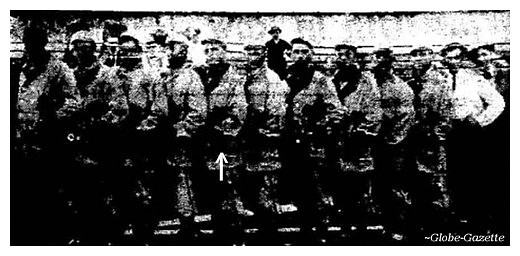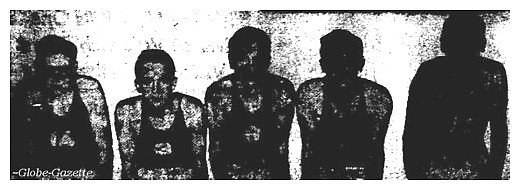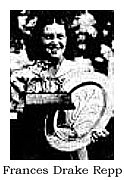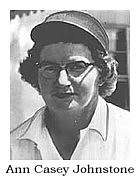


Cerro Gordo County Iowa
Part of the IaGenWeb Project
|
The Globe Gazette
Mason City Has Known Many Champions in the Sports Field

Shown above is the 1910 baseball team which represented Mason City. Fifth from left is Dan Dougherty, who was one of the early baseball managers. The picture was taken at Hanford Park, the site of Central Association games. This park was in the southwest corner of Mason City and the Mason City Brick and Tile plant is in the background behind the bleachers.
What about sports in Mason City during the past 100 years? Mason City has been recognized for many years as one
of Iowa's best sports cities. This is not too surprising because good teams have represented the city in all fields of
sports activities and many of its athletes became famous in various fields. Gathering facts on teams is not easy.
It wasn't until after the turn of the century that sports activities in all fields became recognized as an important
factor in the American way of life. Histories in sports were tabulated only in recent years and statistical information
has come of age only in the past two decades. Even in such a conference as the Big Ten it has been only in the past
10 years that readers took an interest in such things as ground gaining and passing averages in football, shot
percentages in basketball and other facts which will be matched against future performances. This story is not
intended to cover the complete sports activities of Mason City. But it will contain some highlights and
a few interesting features about sports many of which will be news to our younger sports minded generation. We
are indebted for much of the content to Mason City's oldtimers, those who still retain an interest in sports and were
able to recall deeds of former days. Baseball still is regarded as the American game so we'll lead off with the diamond sport. Before the turn of the century there was baseball in Mason City and two teams which were well known were Finnegan's Mules and Watson's Colts. It wasn't until 1902 that Mason City fielded its first professional club. This team was all salaried and played its games on what was called a good field. This was located on South Carolina Avenue just south of the Mason City and Clear Lake Railroad tracks. Much of the baseball history is tied up in the activities at Hanford Park. This was a baseball field located at the southwest corner of the intersection of Pierce Avenue and what is now Highway 106. Unlike most ball parks, which had home plate at the southwest corner, this park had home plate at the northeast corner. At first there were just temporary bleachers but later a grandstand was built - a covered one, too. This old field was straight east of the Oddfellows Home. Dan Dougherty was the manager of one of the early clubs to perform at this park. A baseball reference book says that the Central Association was in operation from 1908 to 1917. Mason City first entered the class D league in 1915. Other members of the circuit were Marshalltown, Clinton, Burlington, Ottumwa, Keokuk, Muscatine and Cedar Rapids. The league opener in Mason City was played on May 6, 1915. The local club was known as the Claydiggers and was defeated in the opener 2-0 by Muscatine. Present for the league opener at Mason City were Gov. George W. Clark, Adjutant Gen. Guy E. Logan and League President E. M. Sexton. Mayor Truman Potter threw out the first ball in the opening ceremonies. The lineup for the Claydiggers listed Branson, 1b; Bay, cf; Brock, ss; Berglin, rf; Vinson, 3b; Welch, 2b; Harrison, lf; Weeks, c; and Garrett, p. Harry Bay, the center-fielder, was the manager of the team. Later Dan O'Leary was the pilot of the Mason city club. The league folded in 1917 as the United States became involved in World War I. The grandstand was torn down and it's understood that some of the lumber was used at the fairgrounds. This site was not used for organized sports activities again until the late 20s. From about 1929 to 1935 it became the site for softball play with temporary bleachers used at the grounds. The Central Association teams all had a rough time in financing baseball and Mason City was among those experiencing difficulty in getting enough dollars to keep the sport going. That seems to be part of baseball, raising enough money, even now, in 1953. Mason City is seeking financial gifts to keep a club going in the Iowa State semi-pro circuit. Baseball didn't die out, however, because the Central Association ceased to exist. There was semi-pro ball in the 20s. One of the semi-pro parks was located just north of Highway 18 west of Mason City. This was a little west of the new Willowbrook addition and across the highway from what now is the Blackmore Gardens. There were other diamonds, too. One park was off N. Monroe in the area adjoining the railroad yards. Northwestern and Leigh Cement Companies had diamonds as did the Mason City Brick and Tile. There also was a diamond in use on the inside of the race track at the North Iowa Fairgrounds. Surrounding towns played games there at fair time. Emory, midway between Mason City and Clear Lake, also had a ball park and was the scene of semi-pro baseball games. The Emory park was in use just after the turn of the century. The youngsters now playing baseball probably don't remember where baseball was played before Roosevelt Field was built as part of the extensive southside athletic plant. Games were played within Roosevelt Stadium, which now is used only for football and track. Some special mention should be made of Junior Legion baseball because Mason City was one of the first cities in the nation to get into the program. This was in 1929 with Marshalltown winning the crown. This fine youth program was benefited in its early stages through the help of individuals who saw a great future in the game as an organized plan to work with youngsters. Mason City long has been prominent in Junior Legion baseball and had state championship teams in 1941, 1944 and 1948. Junior Legion baseball actually was running before Mason City High School began to develop the sport. In fact, equipment from the Junior Legion team was loaned to the high school to get the Mohawks on the way. The first Junior Legion state tournament to be played in Mason City was in 1942. Then for eight more summers the state meet was played here. There also were regional tournaments (4-state) at Roosevelt Field. The state meet has been at Carroll the past two summers but will be back in Mason City in August of this year. To complete the baseball history from a youth standpoint, the Mohawks emerged as a power in high school baseball and in 1935, 1937, 1938 and 1946 won state high school championships. The state high school meet has been held for seven years at Roosevelt Field. Iowa has been referred to as a basketball state. this is because of the vast fan interest in both high school and college basketball. The prep program involves more than 900 schools and the fine basketball gyms throughout the state serve as the center of community activities in the smaller towns. High school basketball had its start in Mason City in 1909. The Mohawks played their games in the armory as there were no high school gyms for the sport. This old armory was located at a site just west of the present central fire station. Playing on the 1909 squad were Charley Crumb, Ralph Wiley, Ross Potter, Harry Swarner, Vern Charles and Louis McFadden. Perhaps the all-time great to play for Mason City was Chuck McConnell, who later went on to All-American honors at the University of Iowa. His defensive play was considered the best of any player ever developed in this state. [McConnell was inducted into the Iowa High School Basketball Hall of Fame.] There have been a great number of fine cagers developed at Mason City High School. Iowa Daily Press Association records show that 14 Mohawks have gained first team all-state honors in IDPA selections.
The Mohawks have also have had three state championship teams. The were in 1935, 1940, and 1943. The 1940 and 1943 teams went through their complete schedules undefeated. This has been matched only by Melrose, which pulled a surprise when the little class B school took the 1937 championship without a setback.

Shown above is the starting five of the 1940 Mason City High School basketball team which went through 32 straight games without a setback in winning the state title. Left to right are Bill Barbour, Max Major, Don Pickell, Bill Colloton and Jim Humphrey. This was a remarkable defensive unit which limited opposition to an average of 18-1 points per game over the 32-game schedule. The Iowa Daily Press Association named this unit as a special all-state team, then went ahead and picked other standouts in the state on the regular all-state selections. [Pickell was inducted into the Iowa High School Basketball Hall of Fame.] He coached first at Columbia (the Dubuque school
now known as Loras), then compiled a brilliant record at Holy Cross before going to Iowa U. in 1939. Dr. Eddie's '39 club
caught the praise of the nation as its "Iron Man" performers lost only one game and lifted the Hawkeyes out of
the football depths. He returned to Holy Cross and twice has been head coach of the College All-Stars.
Anderson was a member of the famous 1917 Mohawk football team. Other great stars of that club were Lawrence Weston,
Lester Belding and John McConnell. Weston later earned All-American honors at Wisconsin. Mason City High School has
had other great football teams. The 1935 club was undefeated but tied once. The 1937 team swept through
undefeated and the 1940 Mohawks had a perfect mark except for one tie. In 1942 the Mohawks were acclaimed state
champs as they roared past all Iowa opposition but were tied by Lindblom of Chicago in a special Armistice Day
game which matched Mason City against the second ranking team in the Windy City. Even the oldtime football followers
are of the opinion that the '42 club was the best turned out at Mason City. Bud Waters coached the great 1917 team
while Judge Grimsley coached the 1942 grid machine and also coached all three state championship basketball
teams. Mason City football games formerly were played on what is now the upper diamond at East Park. Wrestling is
another sport in which the Mohawks have been strong. The first state title came in 1923. Mason City pulled a surprise
in recent years by copping two straight championships in 1949 and 1950. One of the top wrestlers turned out by the
Mohawks is Snip Nalan*, who will be a senior at Michigan next fall. He was the Big Ten and NCAA champion at 136 pounds
this past season. Mason City has produced some great track performers, too. The Mohawks took state championship
in 1918, 1929 and 1930. There has been a recent upswing in track activity and it is hoped that there will be a
return to former greatness. The city now has two golf courses, the Mason City Country Club and the Legion Community
course. The latter was an 18-hole course in former years before being reduced to the present 9-hole setup.


Will some sports die? Will there be some new ones to catch the fancy of participants and spectators?
It would be nice to be around when Mason City celebrates another 100 years of history just to see what has
changed. Even 25 years could change the picture.
Nalan began his coaching career in 1960, teaching two years at Postville High School,
then a year at Drake University. He returned to the prep ranks in 1962 at Grand Rapids Minnesota High School. He has
a record on 178 meet wins against 56 losses and a tie at Grand Rapids with a career mark of 194-76-2. He was inducted
into the Iowa High School Hall of Fame in 1986, and the Iowa Wrestling Hall of Fame in 1983.
Unless otherwise noted, photographs courtesy of The Globe-Gazette.
|
Return to Mason City Centennial Index Page Return to History Index Page Return to Cerro Gordo Home Page